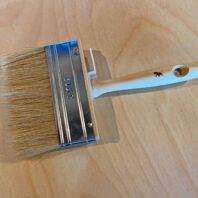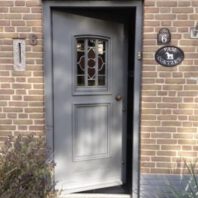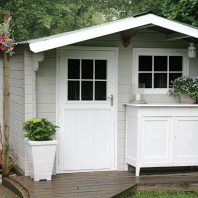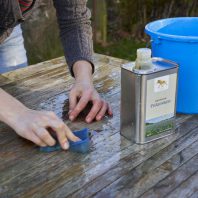Painting a wooden house
Opt for a sustainable result and low-maintenance
Are you going to paint your wooden house? Moose Färg wood paint is an excellent choice!
Painting a house is quite some work – to put it mildly. Therefore, you require a paint or stain that is not only great-looking and cost-effective, but also easy to maintain. In Sweden, they do know how to do so: there, they have been protecting their wooden houses with Swedish wood paint for generations.
Moose Färg paint is a perfect choice for painting a wooden house, like a Swedish cabin or Scandinavian chalet. It is also a great option to give your wooden facades and paneling a fantastic matte appearance with the original Swedish paint.
On this page you will read:
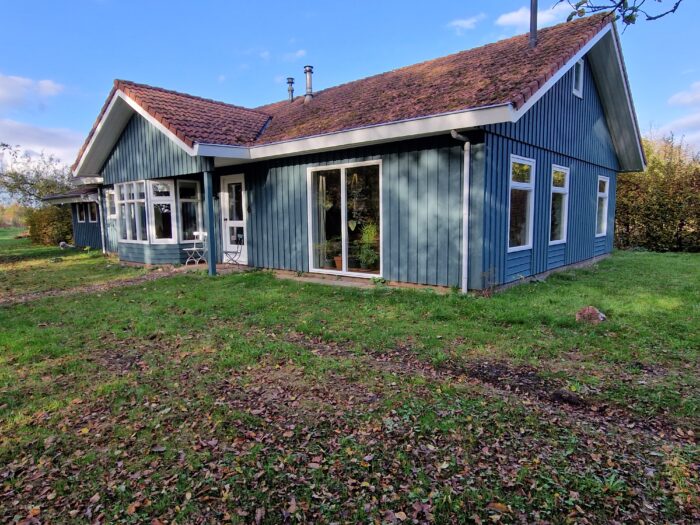
Painting a wooden house?
Why Moose F is the ideal option for painting your wooden house:
Wood has always been a popular building material. It radiates a natural look and has pleasant characteristics. In Sweden, houses in the outlying areas are actually built with wood by default – often from local spruce or pine. It is an environmentally friendly building material and ensures a pleasant living environment due to its breathable nature. If suitable wood protection products are used, wood is also very maintenance-friendly.
It is important to properly protect wood in the Netherlands. Certainly against mould growth, UV radiation, moisture and other weather influences. It is very wise to use a breathable paint system for this. Wood shrinks and expands due to moisture differences. A classic painting system will crack and peel under these circumstances. When using a moisture-regulating paint like Moose F, this problem does not appear.
- Easy: both in application and maintenance, Moose F is child’s play
- Versatile: suitable for all wooden substrates, including treated wood, red cedar, pine, spruce, larch and Douglas fir
- Breathable: creates a vapour permeable surface that allows the wood to breathe
- Unique: the fully matt Swedish colours give a unique look to your house
- Read more advantages of Moose F →
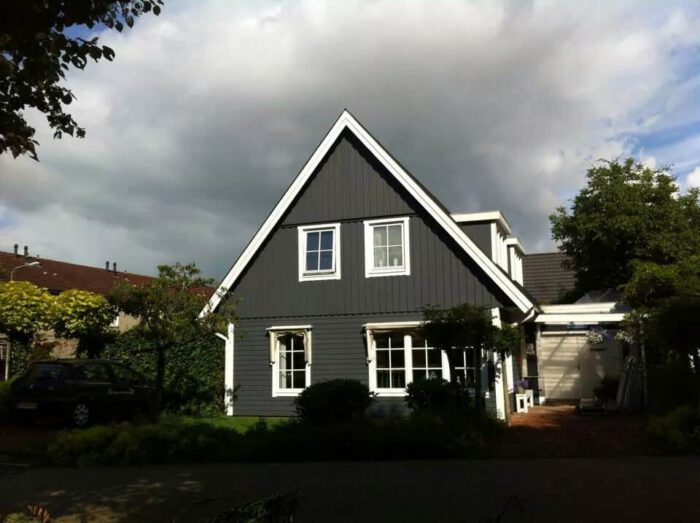
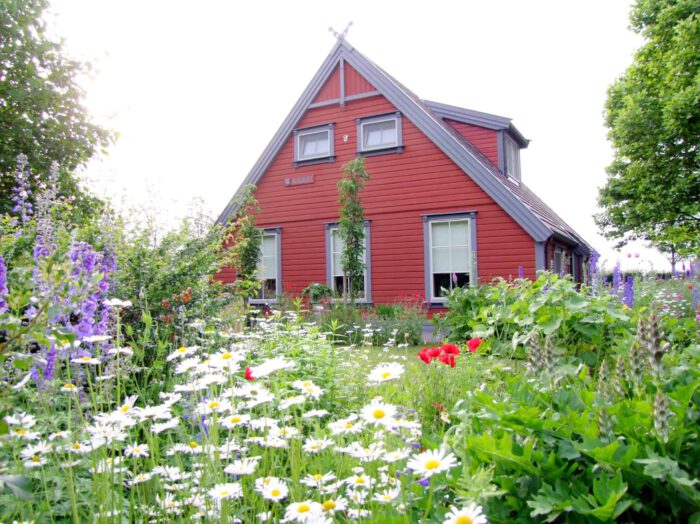
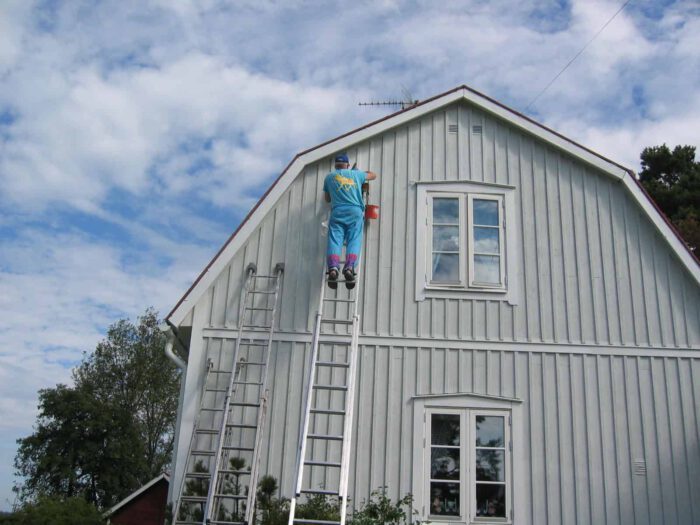
Step by step: painting a wooden house
Useful tips and tricks for the best results
Although painting with Moose F is very easy, it is good to “know” your wood. Wood types have different characteristics and previous treatments can also affect the adhesion of a new coat of paint. We provide pre-processing advice below for good adhesion of Moose Färg paint. You can always contact us for any additional advice.
- Give new wood time to settle
An important condition for painting a house is that the wooden surface is in good condition. Moisture content in the wood is crucial in this respect. A moisture content of 17% is ideal for painting. It is important to avoid painting wood that has had a high moisture content for a long period of time or wood where the core is not yet well balanced with the surface. On the other hand, if wood is too dry, the paint will absorb too much paint.
Before painting a wooden house made of new wood, it is wise to give the wood time to breathe and “settle”. Sometimes this is already done at the supplier, but not always. - Cleaning the wooden surface
Cleaning the surface is very important because of fungi and algae. You can do this, for example, with a high-pressure sprayer and wood soap Polarsken. The wood must be clean and well degreased before painting.
- Painting a disassembled house
If you still have to assemble the wooden house, it is wise to first paint the tongue and groove and possibly put a first thin layer on the wood. This prevents shrinkage and expansion seams and also preserves the tongue and groove.
Tip: Don’t forget to rub the nails with some linseed oil. This prevents rusting and moisture penetration, even if you work with stainless steel nails. Especially if you don’t hammer the nails but use a nail gun. Nail guns make a bigger hole in the wood and you’ve got to fill those afterwards. - Painting an old wooden house
It is no problem at all if a house is on the older side. The wood must be free of mould (inspect for black dots) and dirt. Clean the wood well and remove loose wood splinters. This can be done, for example, with a high-pressure sprayer.
- Painting a house that has been previously painted or stained
The pre-treatment depends on the condition of the old paint layer. It is very important that the old paint layer cannot peel, does not shine and is clean. If the paint peels or is sensitive to peeling, you must first remove it. Roughly sanded paint residues that are firmly attached are no problem and can be painted. Moose F is fully opaque, so you do not see any colour differences after painting.
Is the old paint layer not flaking, but is it shiny? Then sand well with grit 80. This way, the paint can better reach the pores of the wood. Old lacquer must be sanded off completely. The paint does not adhere directly to a coat of lacquer. - Treat with an anti-fungal agent
If necessary, treat with an anti-fungal agent.
- Apply the paint
The paint is easy to apply with a brush, roller or paint sprayer. Dilute the paint extra with water when using a paint sprayer, how much depends on the nozzle. Make sure that you do not spray into the insulation.
Usually two coats of Moose F are sufficient for an opaque result. For lighter colours – such as white or yellow- you might need three coats. Sanding between the layers is not necessary, and even inadvisable. - Maintenance
When cleaning the wood after painting: simply use a brush and wood soap. Maintenance is easy: when touching up the paint layer, you do not need to sand. Just clean the wood and apply a new, thin layer of paint. In this way, you can enjoy the painted surface for years to come.
The unique Swedish colour palette: which colour do you choose?
Of course, the colour that you see on your computer screen strongly depends on your screen settings. Therefore, it is advisable to take a look at different photos on our website. They give a good impression in different types of daylight. You can assess the colours in real life by requesting our free colour card. The colours on the card are painted with the paint itself, so you will get a good impression of the colour as it is.
Are you looking for a specific colour? For example ral 9001 (cream white)? Make sure to order a customised colour, choosing a colour from the RAL or NCS colour system.
A selection of Moose Färg F breathable wood paint colours:
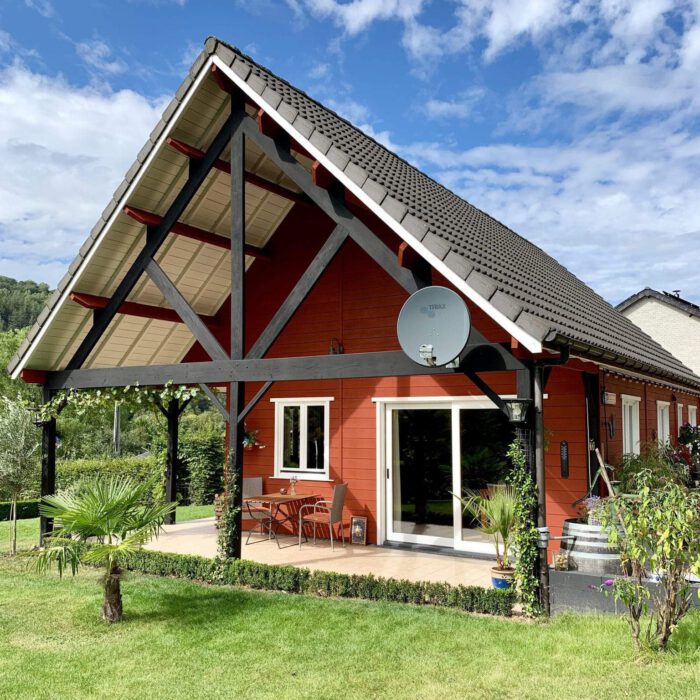
Repainting an already painted house
Painting a previously painted house? If an old coat of paint is still present, Moose RDM can be a better choice. This applies for window frames, but also for paneling in a heavy high-gloss paint. The often heard rumour that water-based paint is not applicable over solvent-based paint is not correct. For the most part, Moose F or Moose RDM can be used, provided that the pre-treatment is done properly (rough sanding, cleaning, no grease and allowing the first layer to dry thoroughly). It is particularly important to sand through to the base layer. The wood should not be smooth or shiny.
In doubt which paint type is suitable for your project? Please contact us.
Bep Broersen (Belgium): “Painted the whole house with Moose Färg. It makes me very happy, in the mostly dark Ardennes.” (translated from Dutch)
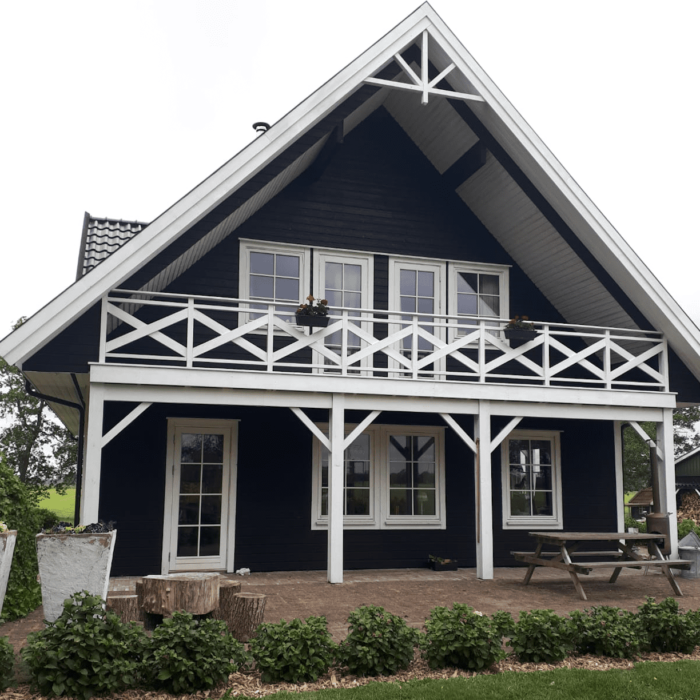
Painting window frames with Moose RDM
Paint type Moose RDM is very suitable for painting window frames and doors. The paint is a so-called ‘high solid’ paint, which has better adhesion and coverage on hard and smooth surfaces. Moose RDM, just like Moose F, has an environmentally friendly composition.
Unlike Moose F, Moose RDM needs a primer coat to adhere properly. You can do this with a layer of Moose F or if your window frames are already primed you can use that layer.
Make sure to contact us for detailed advice.
Get inspired!
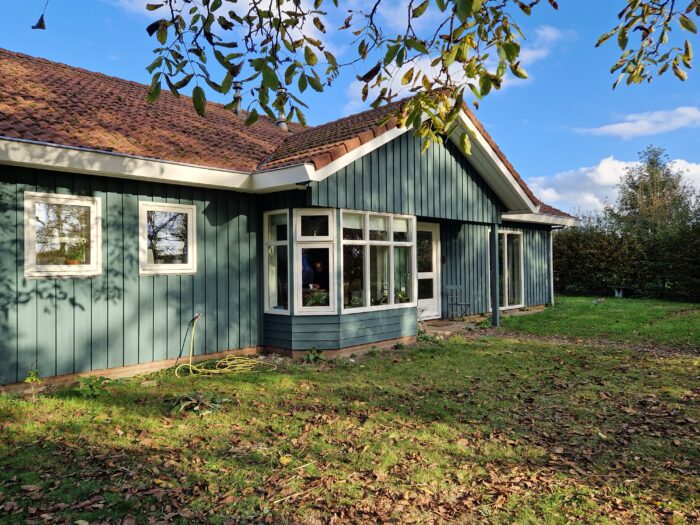
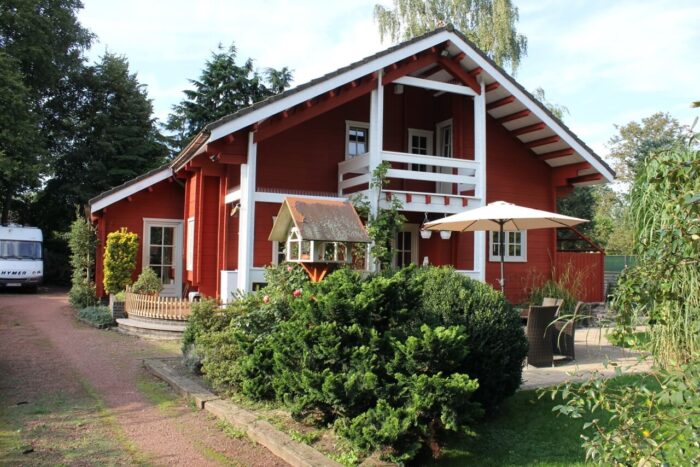
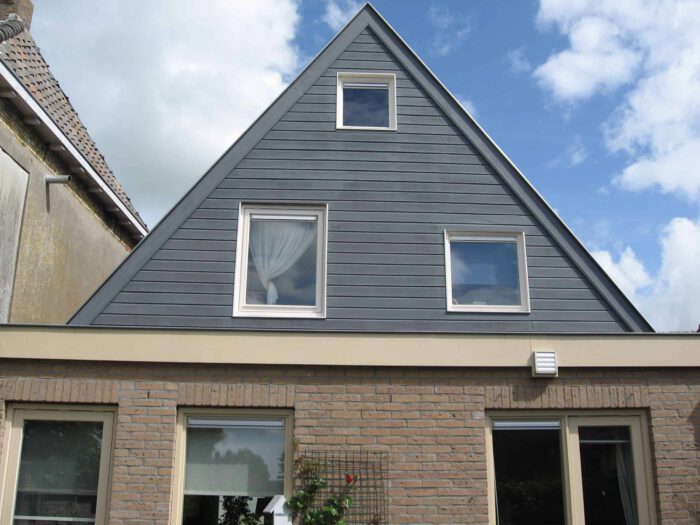
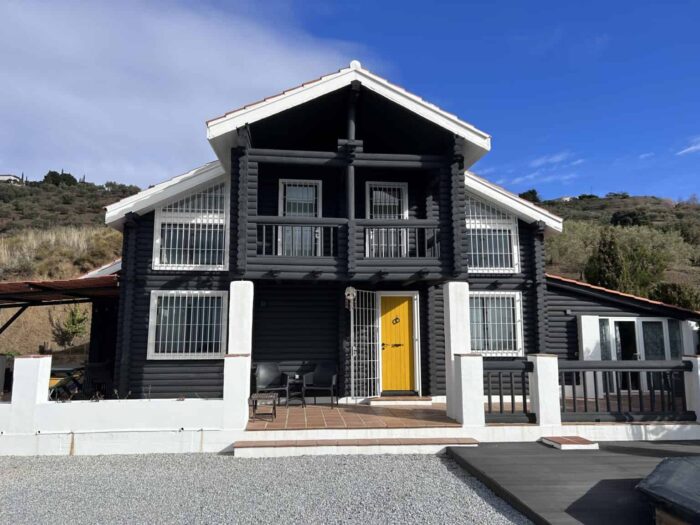

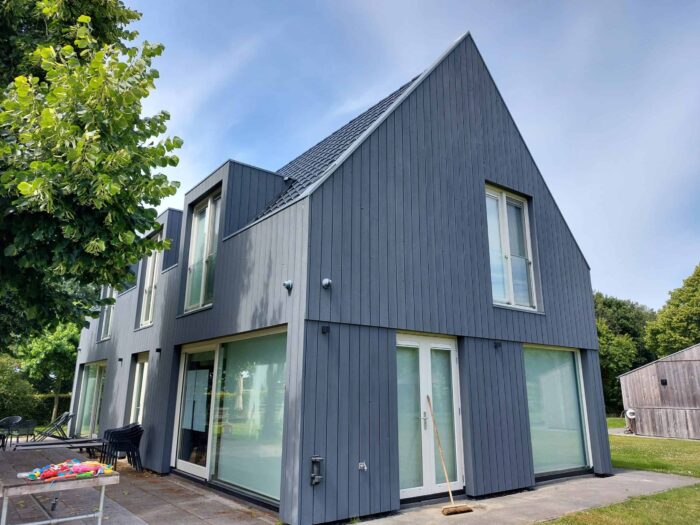
Wood too dry or too wet
Ideally, the wood is air-dry with 17.9% moisture when painting. If it has been very warm and dry, it may be wise to lightly moisten the wood before painting. This will make it easier to process the paint.
If the wood is very fresh, there is still a lot of moisture inside of the wood. Fresh wood “bleeds” and juices can seep through the paint due to its vapour-permeable nature, leaving small marks on the paint layer. No worries: if this happens, you can easily brush over afterwards.
At the end of the season or after winter, make sure to check your paintwork again. The paint absorbs into the surface and you may not have hit all areas equally well. The shrinking and expanding of the wood may expose pieces of wood. You can touch up locally or just lightly brush over everything. This will not be noticeable and provides optimal protection for years to come.
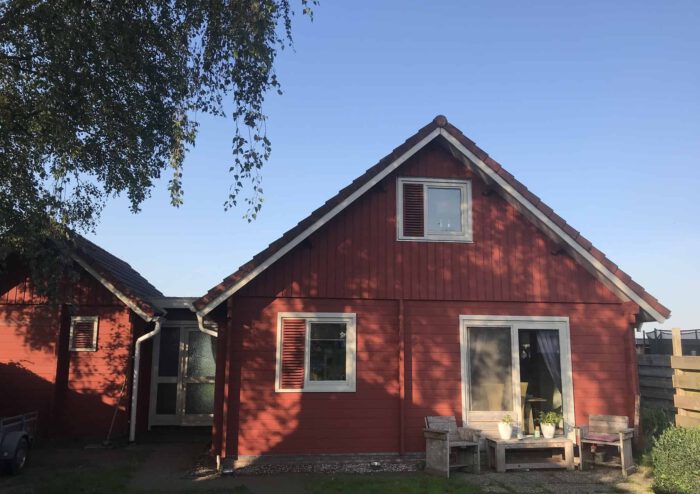
FAQ: Painting a wooden house
This depends on various factors, such as the condition of the wood, the quality of the paint and the weather conditions to which the house is exposed (e.g. strong sunlight). Moose F paint absorbs into the wood like a stain, allowing the wood to breathe. As a result, the chance of flaking of the paint layer (with the correct pre-processing) is close to zero. After a few years, the paint may start to fade. In that case, just easily clean and repaint one layer. This is enough to enjoy your painted house for years to come. The sun-side of the house is more likely to fade than the shadow-side.
Would you like additional, personal advice?
We are happy to help. Send an e-mail or call +31(0) 6 55 333 165. Watch our Instruction Video for more information. Apply here for a free color-card.


